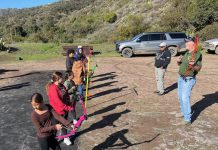The Catalina Island Conservancy Annual Symposium, sponsored by the Port of Long Beach, began in its new virtual format this week, reaching people around the Island, across the Channel and beyond. Conservancy Botanist and Native Plant Manager Seth Kauppinen presented ‘A Flora Apart: Plants of Catalina Island, Past and Present,’ which delved into Catalina’s plant communities in the context of palaeoclimatological trends across western North America.
One thing that makes Catalina unique is that is it dynamic, subsiding at least three times up to 3,000 feet below the waves before reemerging. Geologists call this rollercoaster tectonics or porpoising. It does this at a rate of about three feet per 1,000 years. This might sound slow, but it’s quite fast in geologic time. It most recently reemerged from the ocean about 500,000 years ago.
“All of the life that’s currently found on the Island has colonized within that time frame,” he said.
He explained that Catalina Island is part of the California Floristic Province, a biologically distinct region that extends from southwestern Oregon to northern Baja California.
“It’s a biodiversity hotspot – one of 36 globally – that together hold roughly two-thirds of the world’s species in less than 3 percent of the world’s land area, so it’s a very special place,” said Kauppinen. “The CFP has more than 5,000 species of vascular plants and just over one-third are found nowhere else.”
These endemic taxa are only found in one place. It’s important to note that not all natives are endemics, but all endemics are native.
There are two main types of endemic species. Paleoendemism refers to when a species of formerly wider range contracts its range and becomes secondarily isolated. One example of this on Catalina is Lyonothamnus, also known as the Catalina Ironwood. We know this is paleoendemic because there is a fossil record that shows three named fossil species of this group that were growing as far away as Nevada and the California desert around 15 million years ago.
“As the climate dried out, they could no longer grow throughout most of their former range and they retreated to the more mesic, welcoming climate of the Channel Islands, so we’re kind of their retirement home,” Kauppinen added.
Sibara filifolia is a Channel Islands neoendemic species, meaning that it evolved in situ on Catalina Island.
“With all of that uniqueness and isolation, you may imagine that islands are especially vulnerable to extinction, and indeed they are,” he said. “Regardless of what taxon you’re speaking of – birds, bugs or plants – if they’re found on islands, they’re more likely to go extinct.”
To combat the vulnerability of island species, Catalina Island Conservancy focuses on protecting rare taxa and endemic species. This work includes fencing, keeping out deer and other threats, as well as outplanting.
“The most important thing in thinking about the preservation of the Island’s taxa is just to preserve genetic diversity,” said Kauppinen. “That’s one of the missions of the Ackerman Native Plant Nursery.”
Currently there are 13,316 plants in propagation representing 42 taxa, growing everything from native grasses to trees. The “crown jewel” of the nursery is the seed bank, which represents several decades of work and houses 269 taxa of plants in seed forms, representing more than 3,246 separate field collection events.
“It is a critical resource for the conservation of genetic diversity on the Island,” he said
Watch the entire presentation and sign up for the next talk in the series at catalinaconservancy.org, in which Conservation Operations Director Laura Minuto will discuss precipitation on Catalina Island.











